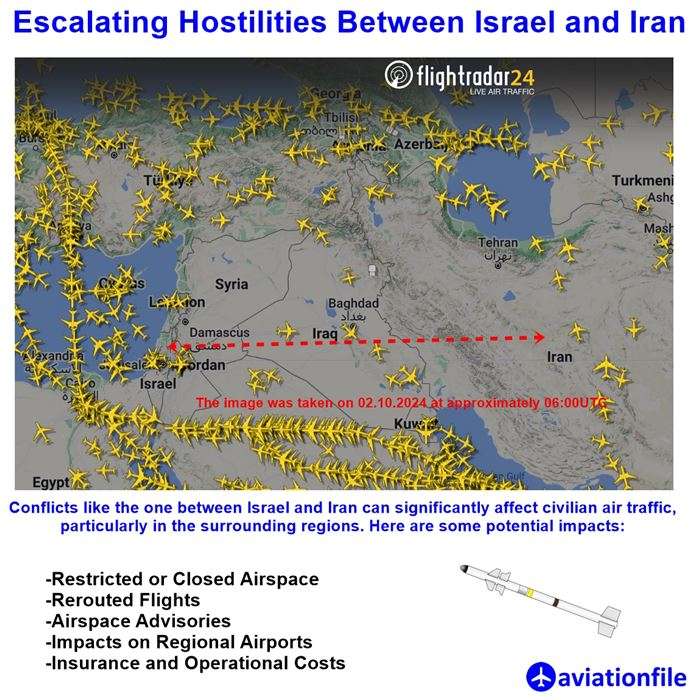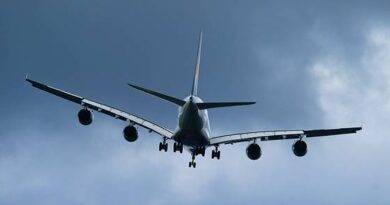Impact of the Iran-Israel Conflict on Civil Aviation: Airspace, Airlines, and Flight Safety in Times of War
The ongoing geopolitical tension between Iran and Israel has far-reaching consequences across various sectors, and civil aviation is no exception. Air travel, airspace management, and the operations of international airlines are deeply impacted by these conflicts. This article delves into how civil aviation is affected during times of war, with a focus on the challenges faced by airlines, restrictions on airspace, and the overall safety of flights in regions of escalating conflict.
1. Restricted Airspace and Flight Routes
The most immediate impact of the Iran-Israel conflict on civil aviation is the restriction or closure of airspace. Both Iran and Israel control large swathes of airspace in the Middle East, a region that is a critical air corridor for international flights between Europe, Asia, and Africa.
- Airspace Closures: In times of heightened conflict, countries involved often impose no-fly zones or completely close their airspace to foreign aircraft. Iran has strategically placed its airspace as a potential deterrent, restricting Israeli or allied aircraft from flying over its territory. Conversely, Israel is known to impose strict regulations on flights during military operations or periods of increased hostility.
- Rerouting Flights: Airlines often reroute flights to avoid dangerous airspace, adding significant time and cost to their operations. A typical flight between Europe and the Middle East may have to take alternative routes, sometimes adding hours to the journey. This not only increases fuel costs but also results in operational inefficiencies, such as longer crew duty times and more maintenance hours for aircraft.
2. Economic Strain on Airlines
The economic burden on airlines caused by geopolitical tensions like the Iran-Israel conflict is substantial. Airlines have to deal with increased fuel consumption, longer flight times, and higher insurance premiums to mitigate the risks of flying in conflict-prone zones. This economic strain often gets passed on to passengers, leading to higher ticket prices, reduced routes, and sometimes a complete suspension of services to affected regions.
- Insurance Premiums: Airlines operating in conflict zones face heightened risks, which translates to significantly higher insurance premiums. In the case of a full-scale military engagement between Iran and Israel, insurers could categorize the region as high-risk, forcing airlines to pay exorbitant amounts to maintain coverage.
- Suspension of Flights: Many airlines opt to suspend services to affected regions entirely during active conflicts. For example, during escalations, major carriers such as Emirates, Turkish Airlines, and Qatar Airways have been known to reroute or cancel flights that pass near Iran or Israel. In some cases, smaller carriers that cannot absorb the extra costs may face bankruptcy or consolidation.
3. Risk to Passenger Safety
Flight safety becomes a paramount concern during times of war. Civilian aircraft can inadvertently become targets or be caught in the crossfire between warring factions. The infamous downing of Malaysia Airlines Flight MH17 over eastern Ukraine in 2014 is a stark reminder of the vulnerabilities that commercial aircraft face in conflict zones.
- Missile Threats: In a highly militarized region like the Middle East, the risk of surface-to-air missile systems is real. Both Israel and Iran possess advanced missile capabilities, and in times of conflict, civilian aircraft can be mistaken for military targets. In recent years, Iranian forces mistakenly shot down a Ukrainian airliner in 2020, highlighting the dangers of operating in tense regions.
- Cybersecurity Risks: As cyber warfare plays an increasingly prominent role in modern conflicts, civil aviation becomes vulnerable to cyber-attacks. Iran and Israel both have significant cyber capabilities, and the risk of hacking into critical aviation systems, including air traffic control and airline communication systems, rises in times of war.
4. Disruptions to Air Traffic Management
Air traffic management (ATM) is heavily affected during times of conflict. Controllers must work around restricted airspaces, creating bottlenecks in global air traffic flow.
- Congested Routes: When airlines reroute to avoid conflict zones, it creates congestion in adjacent airspaces. This has been the case in routes over Saudi Arabia and the Persian Gulf during escalations between Iran and Israel. Congestion leads to delays, extended holding patterns, and a strain on air traffic controllers managing overburdened corridors.
- Coordination Challenges: During conflicts, the cooperation between civil aviation authorities in different countries often diminishes. The hostility between Iran and Israel, for example, hampers any coordinated response to airspace challenges, further complicating the job of ensuring safe and efficient air travel.
5. Impact on Cargo and Logistics
Not only passenger flights but also cargo flights suffer disruptions during times of war. The Middle East is a critical hub for global logistics, especially for the flow of goods between Europe and Asia. The Iran-Israel conflict, with its potential to escalate into a regional war, could disrupt key supply chains.
- Increased Costs for Air Cargo: Longer flight paths and increased security measures for cargo aircraft significantly drive up costs. Additionally, the risk of attacks on logistics hubs or airstrikes on cargo flights carrying essential goods becomes a real concern, further destabilizing global supply chains.
- Shift to Alternative Modes of Transport: In times of extreme conflict, companies may choose to shift from air to sea or land transport for cargo, further delaying the movement of goods. For time-sensitive shipments, this can have a critical impact on industries reliant on just-in-time delivery models, such as electronics and automotive manufacturing.
6. Legal and Diplomatic Implications for Airlines
Airlines flying over conflict zones also face significant legal and diplomatic challenges. The international aviation community is governed by treaties and agreements that regulate airspace use, but in times of war, these agreements may be disregarded or used as leverage by warring states.
- Violation of Airspace: In times of conflict, countries may accuse airlines of violating airspace agreements, which could lead to diplomatic rows, fines, or even the grounding of aircraft. In the case of the Iran-Israel conflict, where both nations closely guard their airspace, airlines must be extra cautious about compliance to avoid diplomatic backlash.
- International Sanctions: Sanctions imposed on Iran have already created complications for airlines operating in the region. Further escalation of conflict with Israel could result in additional sanctions that target Iranian airspace, making it nearly impossible for global airlines to operate without risking penalties.

Conclusion
The conflict between Iran and Israel significantly affects civil aviation across multiple dimensions: restricted airspace, increased operational costs, risks to passenger safety, and disruptions to global air traffic management. Airlines are forced to reroute, suspend services, and deal with elevated insurance costs, all of which lead to higher prices for consumers and logistical challenges for the global supply chain. In an increasingly interconnected world, the implications of such conflicts are not limited to the Middle East but resonate globally, affecting aviation stakeholders worldwide.
As geopolitical tensions escalate, airlines, governments, and international aviation bodies must collaborate closely to ensure the safety and stability of air travel in conflict zones.
The Rising Tensions Between Israel and Iran: A Clash of Air Power
References and Further Reading:
- https://aviationweek.com/air-transport/safety-ops-regulation/easa-advises-airlines-avoid-israel-lebanon-airspace-over-high
- https://sg.finance.yahoo.com/news/airlines-confront-new-iran-israel-risks-as-disruption-grows-011115932.html
- https://www.jpost.com/breaking-news/article-796978
- https://www.icao.int/safety/ConflictZones/Pages/default.aspx


